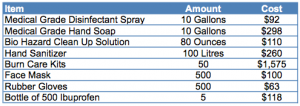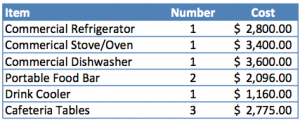Top Five Hidden Costs Of Starting An Indiana Charter School
A few weeks ago, we reported that only 19 of Indiana’s 92 counties have at least one charter school. Most of those are in big cities like Indianapolis and Gary. This got us thinking: What would it look like to start a charter school in a rural place such as Worthington? As part of our ongoing coverage of charter schools in Indiana, we bring you SimSchool. A hypothetical school we created and brought before the chartering officials at Ball State for approval. Here is a list of the five biggest costs associated with starting a charter school that we encountered.
1. Staff

Indiana Department of Workforce Development
Here is a full staff list for SimSchool. You'll note that there are no art, music, or P.E. teachers. All of these positions are paid at a higher rate than classroom teachers and are not required under Indiana state law.
This may not seem like a hidden cost. Any first year business student can tell you employees are always a company’s biggest expense. But if you break this expense down, you’ll see it’s not just a matter of writing paychecks. Schools carry liabilities beyond an average business. This means, for example, a full time nurse to care for students’ health and conduct mandated medical screenings. That costs $57,820 a year in salary — not including benefits.
Then there’s the insurance. Administrators usually have a plan covering lawsuits and the school carries insurance against injuries and accidents caused by staff.
Next you have to add in the support staff. Teacher’s aides weigh in at $21,810 a piece. Librarians make an average of $56,360 a year.
Who leads the pack in terms of cost? Administrators. The average principal draws a salary of $80,460 a year in Indiana, according to the state Department of Workforce Development.
The state requires ongoing training for teachers. The cost of sending seven teachers to training sessions with Bloomington-based Solution Tree totals more than $21,000 a year.
2. Facilities
Again, not necessarily surprising. However, this expense can become a major barrier for schools trying to open outside of urban areas. After hours of conducting commercial real estate searches in rural counties like Greene and Owen, we came to the conclusion that our only option was to build a school from scratch.
For 140 students, this means we would need a building that’s about 20,000 square feet. According to estimates from CSO Architects, the firm behind many schools in Indiana, a project of this size cost slightly more than $2 million.
A low interest loan from Bank of America brings this cost down to $154,095 a year. Not including regular maintenance ($58,000), utilities ($14,000), custodial services ($64,000), and waste disposal ($15,720).
3. Supplies
Have you ever considered the cost of 50 liters of Purell Hand Sanitizer? $260. What about 10,000 rolls of toilet paper? $5,304. 500 florescent light bulbs? $2,564. You’re average school goes through basic supplies at a startling rate.

School Nurse Supplies Inc.
This is a partial list of the many items suggested for SimSchool's nurse. Others included disposable ice packs, anti allergy medication, and a whole range of common cleaning supplies and over the counter medications.
Consider the nurse’s office. We asked a school supply vendor what it would take to outfit an average nurse’s office for one year. The list came to more than three pages of mostly household medicines and cleaning supplies. Children’s Tylenol for fevers, bandages for playground injuries, medical grade disinfectant for cleaning up messes, and record books for tracking student’s with special medical needs.
Add to this things like napkins, trash bags, paper, pens, brochures, food, Windex, business cards, and you’ve got a hefty chunk of change.
4. The Library
How do you teach reading without books? We used the cost of one Goosebumps paperback at an average cost of $5.99 per copy. Multiply this by the 20,000 books needed to stock a small library and your total cost comes to $119,800. For books alone.
Need shelving for your library? Better be willing to shell out more than $5,000. And we’ve already mentioned the cost of hiring a librarian, $56,360.
5. Furniture
Desk? $18,200. Computers? $37,700. Examination table in the nurse’s office? $400. Foam wall pads in the gym? $500.
Furniture is one of those basic expenses that most people don’t think about, but it adds a lot to a school’s start up cost. We revisited this expense more frequently than any other.

Central Kitchen Supplies Inc.
This is a list of furniture and appliances needed to outfit SimSchool with a basic cafeteria. Every room in the school comes with a similar price tag in terms of furnishing cost.
To illustrate this point, let’s look at the school cafeteria. When we first created SimSchool, we outfitted it with a refrigerator, some lunch tables and a stove/oven. Sound about right? But what if your students want something to drink with their meals? Then you’ll need a drink cooler or a juice machine or a milk dispenser. Food can’t just be left sitting on the stove. So you better get a hot food bar, plus a cold food bar for salads. While we’re at it, all this food makes for a lot of dishes, meaning we’ll probably need a dishwasher. Combined, these additions added tens of thousands of dollars to the furniture line of the budget.
All told, SimSchool came in at slightly more than $1.7 million for its first year. This included several deductions for donated time and materials.
